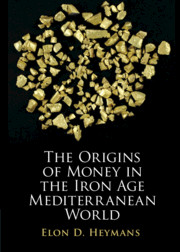Book contents
- The Origins of Money in the Iron Age Mediterranean World
- The Origins of Money in the Iron Age Mediterranean World
- Copyright page
- Contents
- Figures
- Maps
- Tables
- Preface
- Acknowledgements
- Author’s Note
- One Rethinking the Origins of Money
- Two Outline of an Approach to Money
- Three A Study of Iron Age Precious Metal Hoards
- Four Money in the Iron Age Southern Levant
- Five Money in the Iron Age Aegean
- Six Conclusion
- Appendix A Catalogue of Iron Age Precious Metal Hoards in Israel/Palestine
- Bibliography
- Index of Ancient Sources
- General Index
Two - Outline of an Approach to Money
Published online by Cambridge University Press: 17 September 2021
- The Origins of Money in the Iron Age Mediterranean World
- The Origins of Money in the Iron Age Mediterranean World
- Copyright page
- Contents
- Figures
- Maps
- Tables
- Preface
- Acknowledgements
- Author’s Note
- One Rethinking the Origins of Money
- Two Outline of an Approach to Money
- Three A Study of Iron Age Precious Metal Hoards
- Four Money in the Iron Age Southern Levant
- Five Money in the Iron Age Aegean
- Six Conclusion
- Appendix A Catalogue of Iron Age Precious Metal Hoards in Israel/Palestine
- Bibliography
- Index of Ancient Sources
- General Index
Summary
Exploring the vast anthropological and archaeological scholarship on money, this chapter lays out an approach to early money. Examining what it is we refer to when we talk about money, and what effect it supposedly has on society, it becomes clear that money can be diverse and does not have a set effect on society. Rather, the significance of money depends on the social and cultural logic in which its use is embedded. Arguing from this perspective, a distinction between primitive and modern forms of money – or equivalents, such as special-purpose and general-purpose money, or indigenous currencies and state money, with coinage representing modern/general-purpose/state-issued money – is rejected as arbitrary and not conducive to a better understanding of early money preceding coinage. Instead, money is conceptualized as being a commodity and a token at the same time. This is then applied to the material that is placed at the centre of this study – the cut and broken precious metal items generally known as hacksilber and hackgold – thereby substantiating an understanding of this material as a form of money, still preceding coinage.
Keywords
- Type
- Chapter
- Information
- The Origins of Money in the Iron Age Mediterranean World , pp. 17 - 54Publisher: Cambridge University PressPrint publication year: 2021

